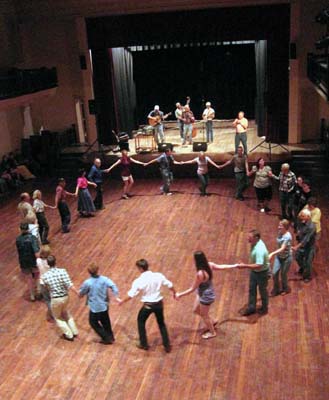"The more you dance, the better you feel":
A Journey along the Mountain Dance Trail
By Becky Hill

Square dancing in Marlinton, Pocahontas County. Photograph by Becky Hill.
On a warm August evening about four years ago, the Dunmore community center in Pocahontas County was packed for the annual Dunmore Daze, a summer celebration that felt like a family gathering. Events had been happening all weekend. When we arrived, the square dance was about to kick off. The smell of hotdogs caked with mustard, ketchup, and onions lingered in the air. Older couples nestled up to one another sipping soda from straws. Children ran in and out of dancers, dodging the swinging couples. Their giggles echoed through the hall. Everyone had half an eye on me, wondering what I was all about. I probably stood out because I didn’t have a dance partner, was excited to dance, and was 21 years old. I grew up practicing different types of percussive dance, including flatfooting, and had attended several Augusta Heritage Center workshops at Davis & Elkins College in Elkins. I’ve always been attracted to social dances with live music, so I instantly felt at ease when I walked into the hall.
Gerry Milnes, who was the Folk Arts Coordinator for Augusta Heritage Center at the time, invited me to Dunmore. Within five minutes, he’d left me on my own and vanished into the string band to become the honorary fiddler of Juanita Fireball and the Continental Drifters. I sat down and started talking to Miss Dorothy, who told me about the old style of mountain square dancing. I found out it usually takes until the end of the night to get everyone up and dancing—after enough sips from Mason jars in the parking lot. Many of the older folks were overwhelmed with nostalgia and eager to tell their stories. I listened as they said many variations of, “Oh, dances are different now.” I heard how dances used to be held in houses, on outdoor platforms on farms, and in beer joints. These stories took me back to a time completely different from today.
Ellen and Eugene Ratcliffe from Monterey, Virginia, were the callers that evening. Everyone who got up to dance knew what to do when the Ratcliffes shouted out, “Ladies do-si-do, gents you oughta know.” All evening, a rotating cast of eight couples filled the dance floor.
A majority of the folks that night came to listen and not to dance, which puzzled me. The floor was almost empty during waltzes, and it struck me that square dancing had lost popularity over time. Although the scene had a vibrant community feeling that resonated with me, community members let me know that the number of dancers had dwindled over the years.
By the end of the evening, I felt like I was part of the community and was grateful to have been welcomed so quickly at the Dunmore Square Dance. I honestly couldn’t think of anywhere else where that kind of interaction was possible. Some people spend a lifetime searching for a sense of community, and I started wondering if square dances could help fill that void. This community square dance had a unique feel. I wanted to celebrate it and introduce others to this rich tradition. I was processing all of these thoughts as we drove through the mountains along Route 219. By the time we arrived in Elkins, Gerry had convinced me to help him build The Mountain Dance Trail to preserve these old-time square dances.
Gerry’s inspiration for the idea was the Ceilidh Dance Trail, which he had visited in Nova Scotia years earlier. Having played for many similar types of square dances in Braxton County, he thought, “We should be promoting traditional dances like this in West Virginia.” Comparing Nova Scotia to West Virginia, Gerry said, “In both places, the people were friendly, open, and inviting to newcomers, and I was sure it could work.”
We agreed on the goal of The Mountain Dance Trail: to honor, embrace, and promote dances at small communities across West Virginia. The project grew slowly. Gerry and I applied for an AmeriCorps position to develop the Mountain Dance Trail, and, in November 2011, I started as a VISTA worker with the Pocahontas Communications Cooperative and Augusta Heritage Center. We also received a West Virginia Humanities Council minigrant and launched a Kickstarter campaign.
Through a Challenge America Grant from the West Virginia Department of Arts, Culture and History, we were able to award honoraria to callers and musicians throughout the state, cover rental fees, and print and distribute a dance schedule. I started a Web site and Facebook page, hung posters, wrote press releases, and began to teach 4-Hers and high school and college students how to square dance.
We intended to document specific community traditions before the word got out—so we wouldn’t alter the traditions that made each community so unique in the first place. We started with 10 dance communities the first year and expanded to 15 the next: Lewisburg, Marlinton, Franklin, Dunmore, Monterey, Riverton, Thomas, Morgantown, Elkins, Helvetia, Pickens, Ireland, Sutton, Glenville, and Henderson.
You can read the rest of this article in this issue of Goldenseal, available in bookstores, libraries or direct from Goldenseal.